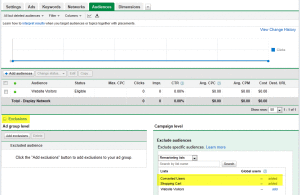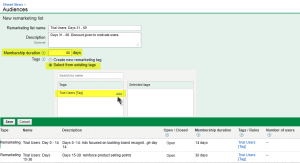I was once pining after a certain pair of shoes on Zappos, but I opted not to purchase them that day. Imagine my surprise when, as I was browsing another site a few days later, I saw an ad for that exact pair of shoes. This experience was my introduction into the wonderful world of retargeting.
Retargeting is the process of tagging every visitor to your website and then displaying your ads to those visitors on other sites in the display network. If you are new to retargeting, I highly recommend starting with a Google remarketing campaign, because it targets prospective customers who have already expressed intent in your brand. If you get stuck at any point in the implementation process Google has written a how-to guide for setting up remarketing campaigns.
However, before you get started, you will need to work out a strategy on how to segment your lists. Lists should be segmented according to a user’s behavior on your site: they can be as broad as tagging every visitor to your website or as narrow as a targeting different visitors at different stages of the trial and buying process.
Retargeting the Casual Visitor
For your most general campaign, target visitors to your website who did not add any products to the shopping cart. The most important step is to add converted users as a negative audience at the campaign or ad group level under “Exclusions.”
This campaign is the broadest targeting method. Therefore, you will want to set the bids low on this campaign because these visitors have the lowest potential of converting. However, this campaign is a great opportunity for branding messages. In your PPC ads, you want to convey that you are a reputable brand.
Retargeting Trial Download Users
Users who complete “mini-conversions,” such as a free trial or a download, should be targeted with messages to upgrade to the full version of a product. For example, if you offer a 30-day free trial of your software, deliver ads to individuals during and after the trial period and encourage them to purchase your product. It’s even possible to stage different ads as the trial period counts down. Here’s an idea for a campaign:
- Days 0-14: Ads focused on building brand recognition to increase reputation and stay in front of the customer’s mind
- Days 15-30: Educational touch points to reinforce product selling points
- Days 31 – 60+: After the trial expires, this may be a good time to offer a discount to motivate these indecisive customers.
Setup a new remarketing list for each stage that you want to target. The good news is that you can use the exact same tag by selecting from “existing tags,” but for each stage, change the cookie duration and list name. After each list is complete, create an ad group for each stage, using the current stage as an included audience, and the earlier stage as a negative audience. This will ensure that you aren’t overlapping audiences and confusing your trial users.
Compliment your drip-marketing campaign (which includes sending promotional emails to registered trial users) with targeted messages. I recommend aligning these efforts to give a solid one-two punch!
Retargeting Shopping Cart Deserters
You can also target users who start the shopping cart process but don’t purchase. Shopping cart abandonment occurs for a multitude of reasons, from the customer simply getting distracted to the product price being too high. Testing your ads is vital in determining what draws them back to the cart. Is it a coupon code or merely the reminder that your product is the solution?
At this point in the conversion funnel, there is no doubt that the user is interested in your product, so you can afford to bid higher on this campaign as long as you measure the ROI.
Retargeting Existing Customers
Regularly remind your reliable customers of all the other great products that you offer. Target these people either to upsell a product upgrade or to cross-sell a complimentary product. This retargeting list would consist of users who visit the final step of your sales funnel: the confirmation page.
If your company offers subscription products (including software, online games or SaaS products) to generate recurring revenue, you can set up lists with different cookie durations to aim the messaging at key points in the billing cycle. Use the steps in the Trial Download section of this post to avoid overlapping messages.
Best Practices
- Avoid stalking people! The most common complaint among users targeted by retargeting campaigns is the feeling of brands following them around the web; in other words “stalking” them. Trust me, you don’t want to go down this creepy path, as over-saturating users can quickly cause negative feelings towards your brand. A simple remedy to this situation is to set a frequency cap on your ads. This can be done in the Campaign Settings by day, week or month.
- A/B test ads to see what converts best. By default, Google AdWords sets the ad rotation to “Optimize for clicks” which is not conducive to testing – you will want to change this in the Campaign Settings to rotate ads more evenly.
- The landing page must be consistent with the offer in the ad If you’re paying for this traffic, don’t make the mistake of sending targeted searchers to untargeted pages. Send the potential customer to a landing page that has a straightforward sales funnel.
- Create banners in many different colors, themes, messages and sizes. Also, be sure to refresh your banners often, especially if you designate a long cookie life.
Retargeting should be a strategic component of every online marketing plan whether you’re looking to drive prospects back to the shopping cart, increase trial downloads or subscription renewals, or even just to promote awareness of your brand.
Are you using retargeting campaigns in a creative way to drive users to your shopping cart? What have you found to be most successful?








